
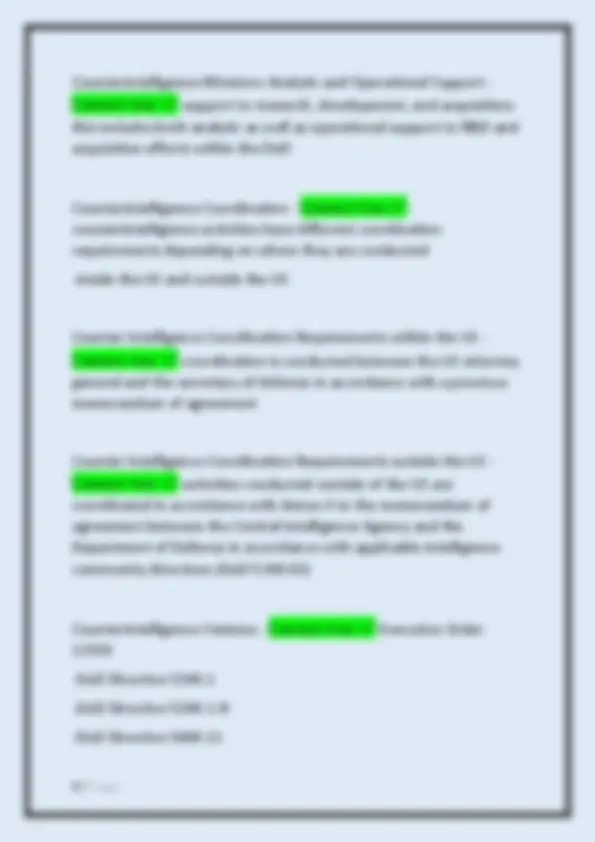
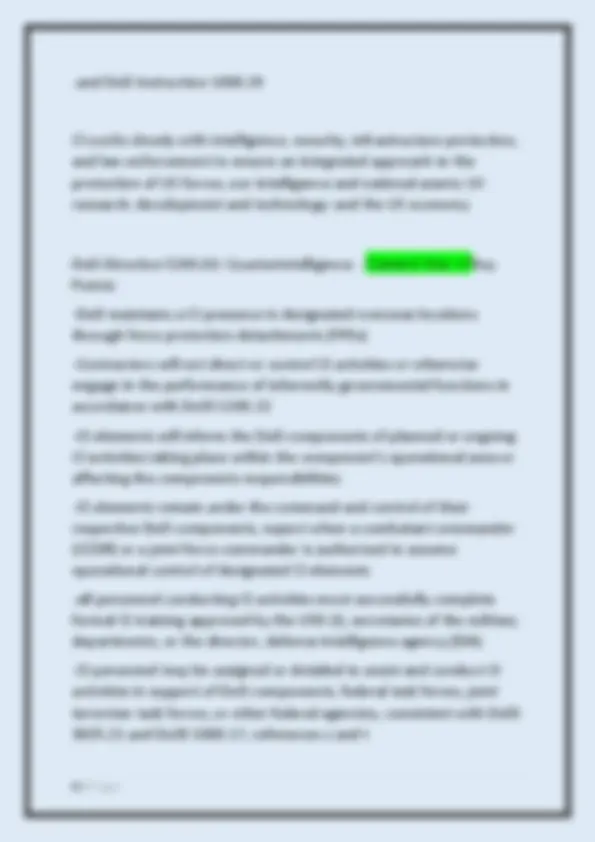
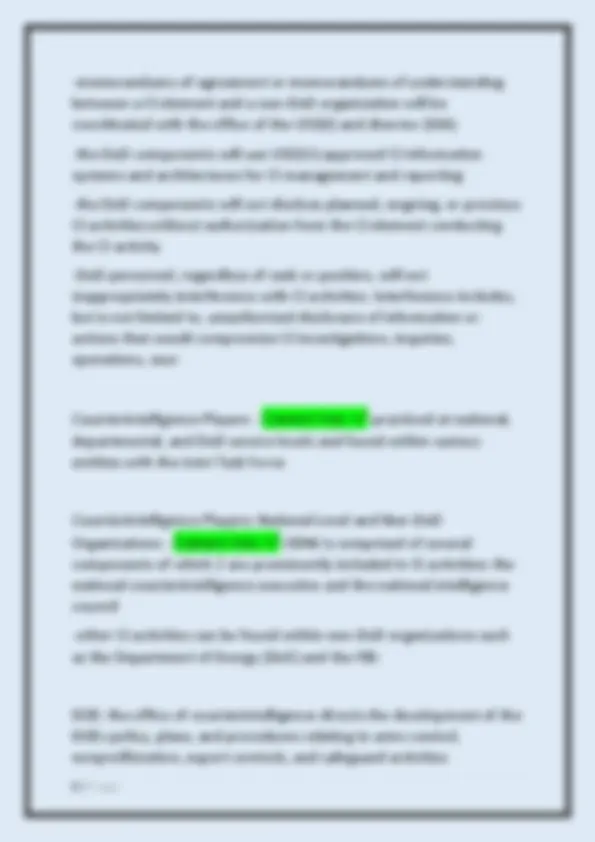
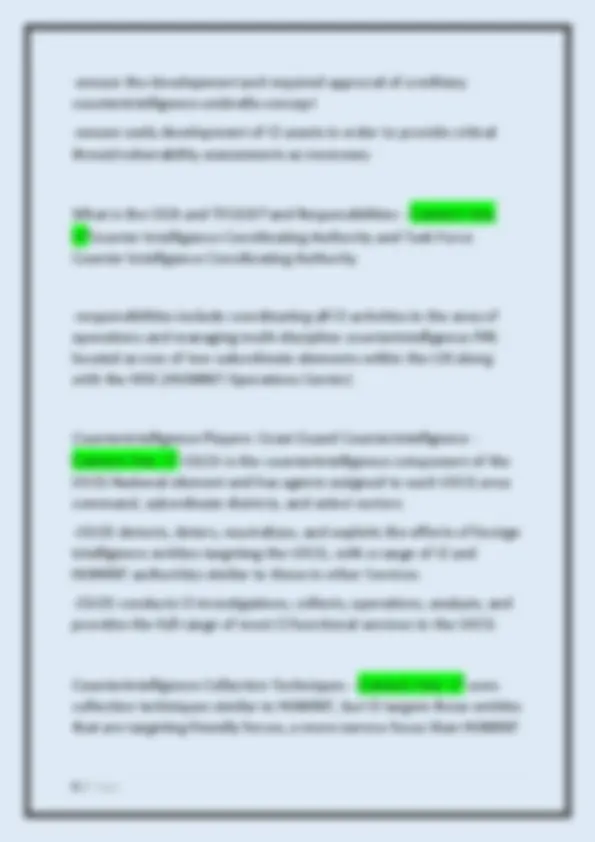
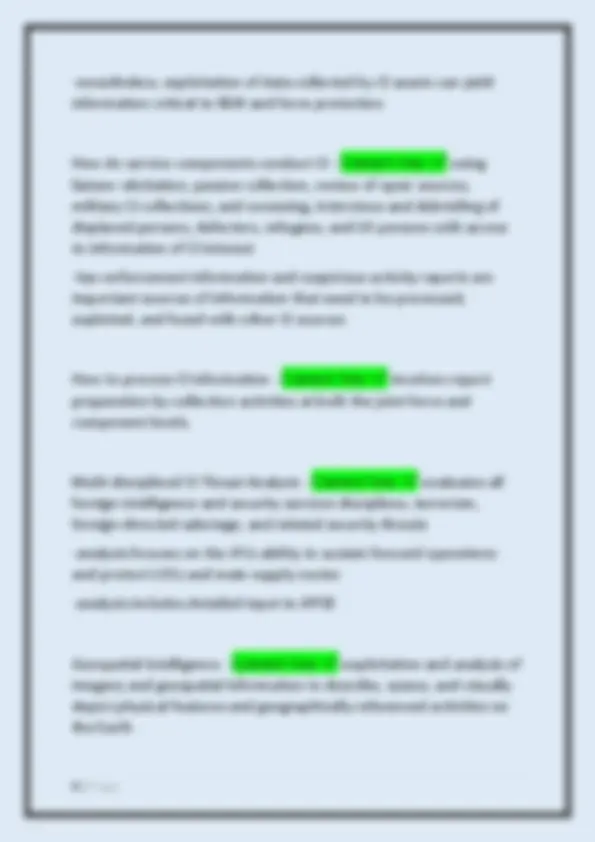
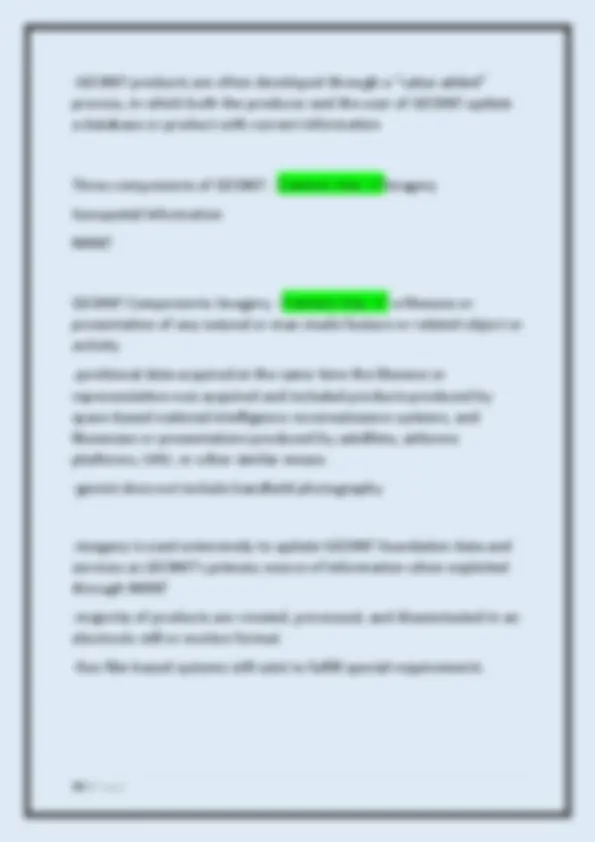
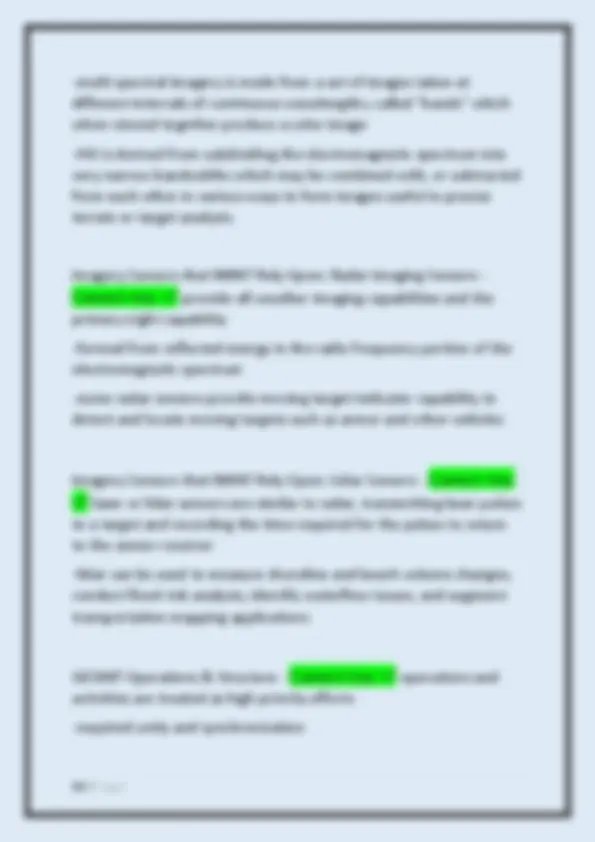
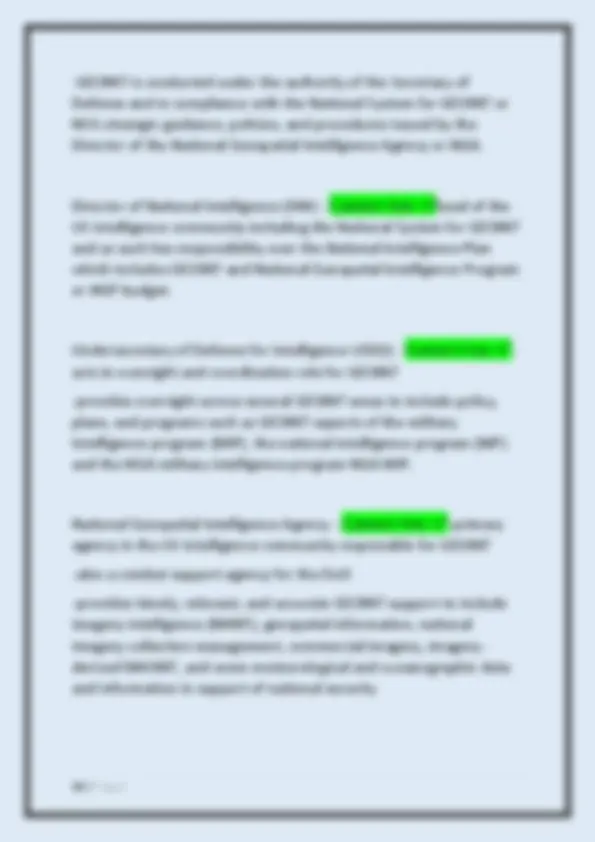
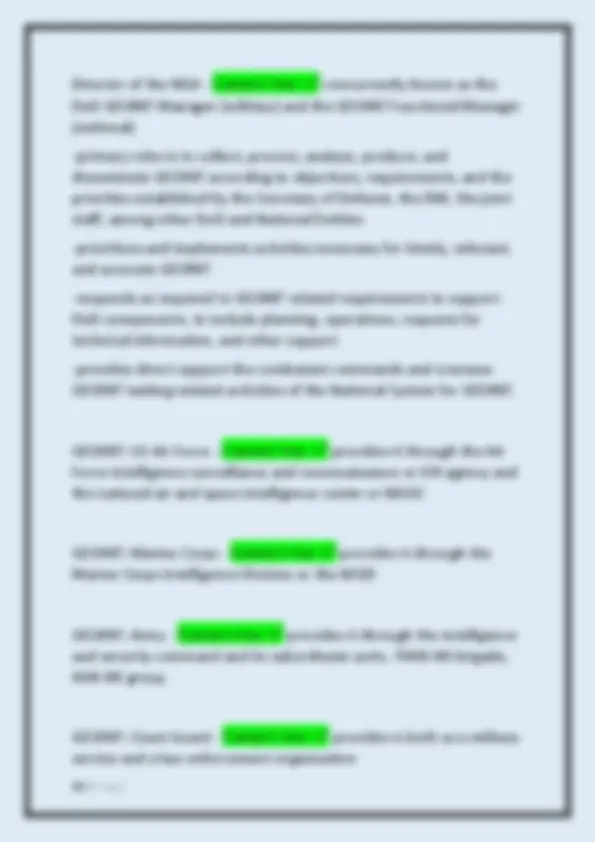
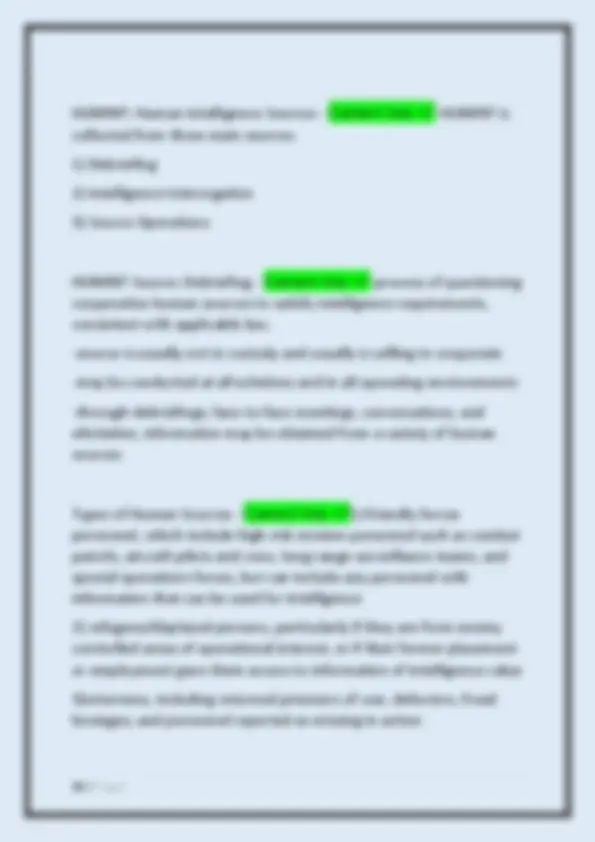
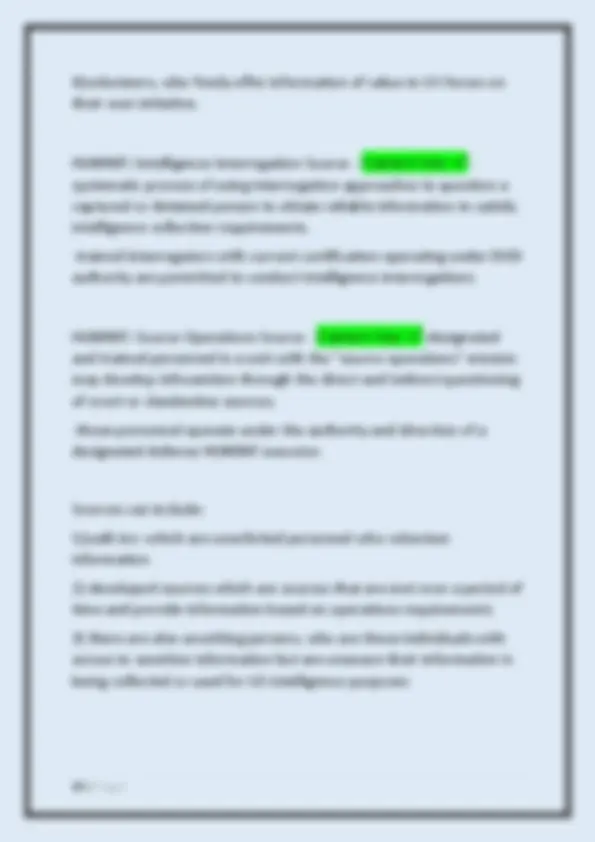
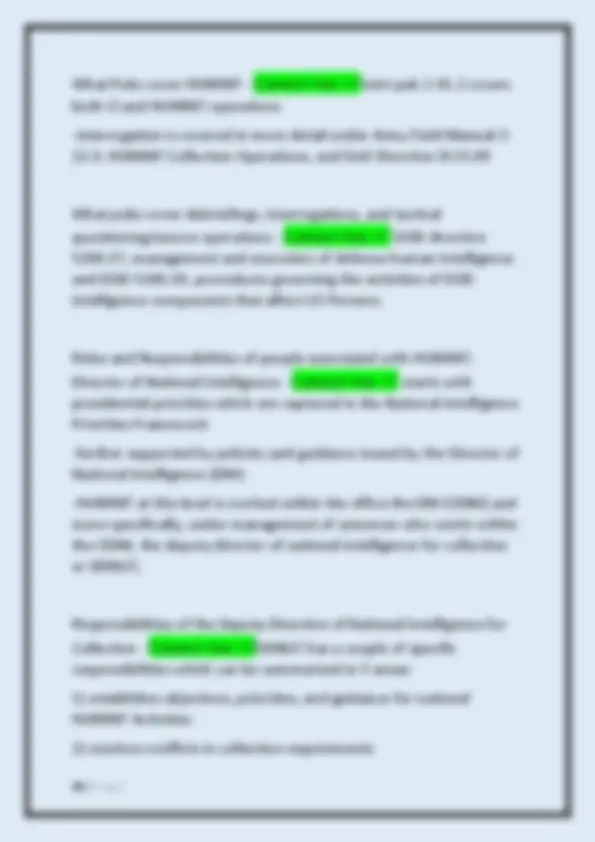
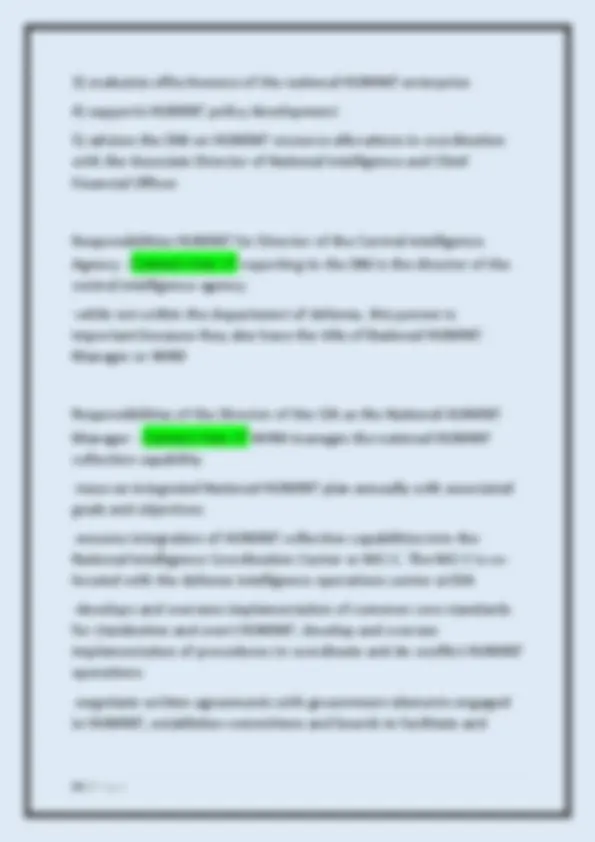
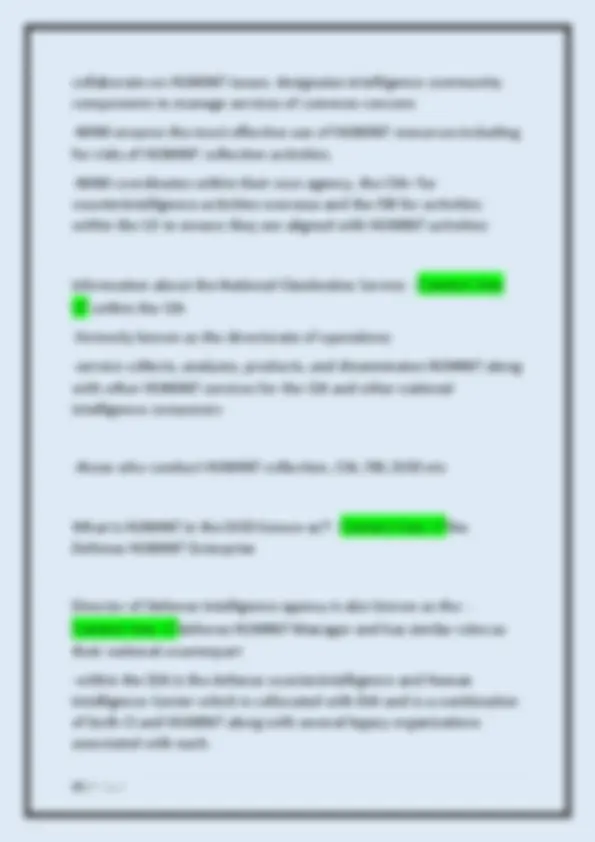
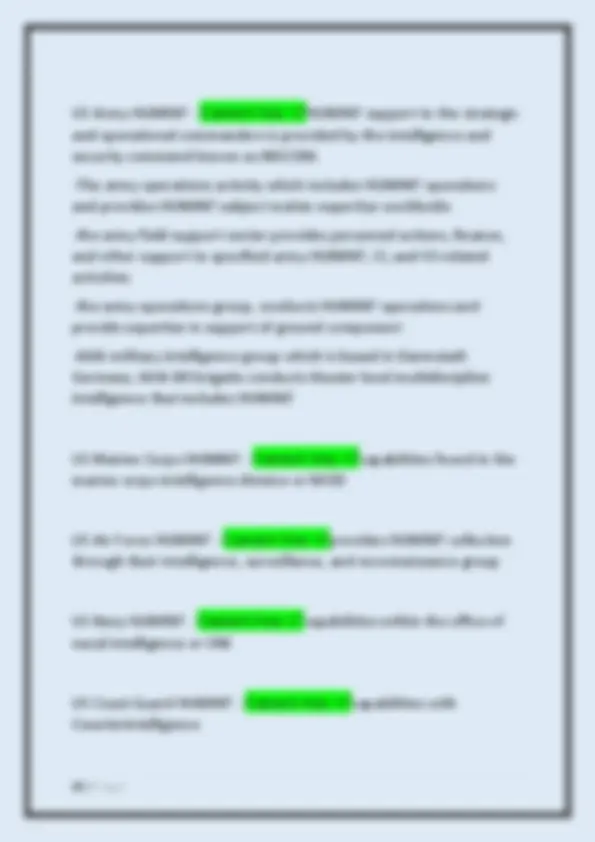
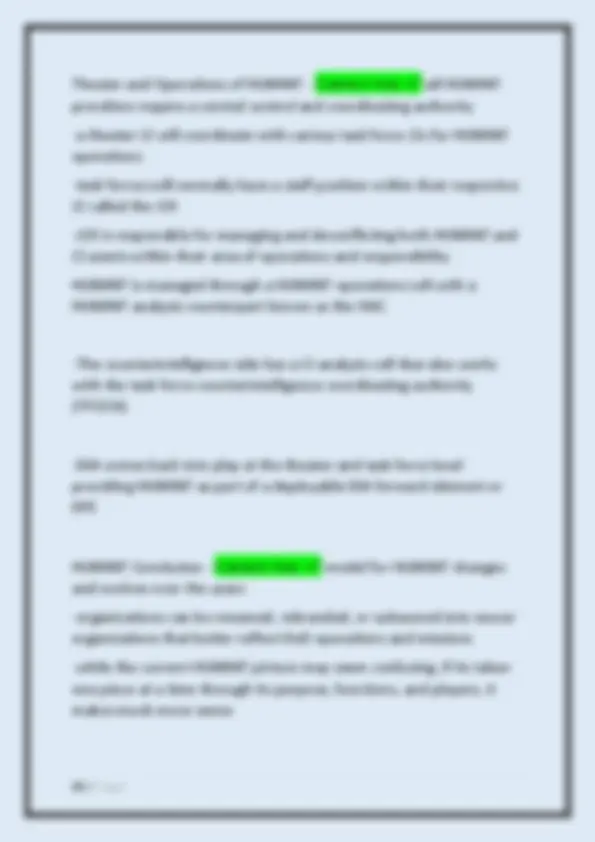
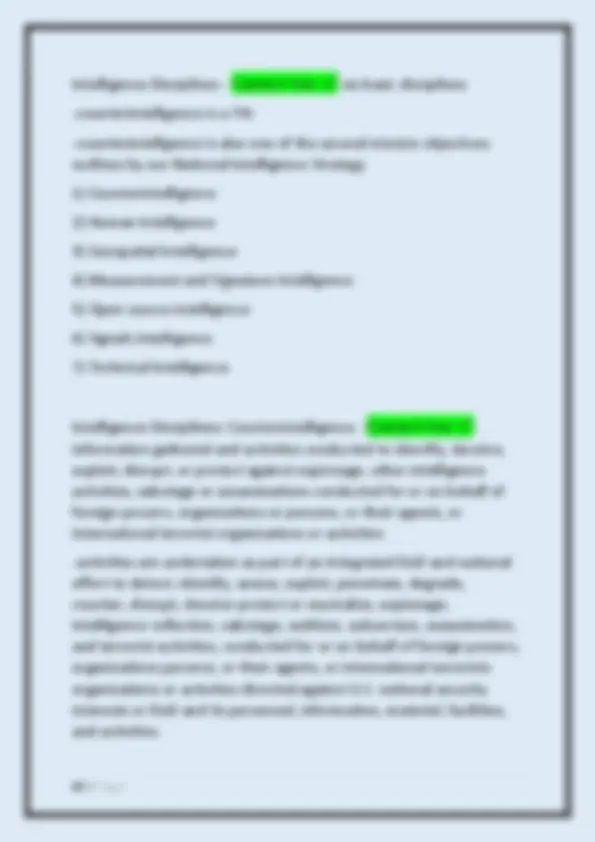


Study with the several resources on Docsity

Earn points by helping other students or get them with a premium plan


Prepare for your exams
Study with the several resources on Docsity

Earn points to download
Earn points by helping other students or get them with a premium plan
Community
Ask the community for help and clear up your study doubts
Discover the best universities in your country according to Docsity users
Free resources
Download our free guides on studying techniques, anxiety management strategies, and thesis advice from Docsity tutors
A comprehensive overview of counterintelligence (ci) fundamentals, covering key concepts, strategies, missions, and players involved in ci operations. It delves into the two-pronged approach of offensive and defensive ci activities, outlines the five core functions of ci, and explores the four primary ci missions: countering espionage, supporting force protection, supporting critical infrastructure, and providing analytic and operational support. The document also examines the coordination requirements for ci activities within and outside the united states, highlighting relevant statutes and directives. It further explores the roles of various ci players at national, departmental, and dod service levels, including the odni, fbi, dia, and joint task force. The document concludes with a discussion of the counter intelligence coordinating authority (cica) and its responsibilities in coordinating ci activities.
Typology: Exams
1 / 25

This page cannot be seen from the preview
Don't miss anything!


















Counter Intelligence Strategy - Correct Ans: ✅-two pronged approach as part of a comprehensive CI strategy that feeds more effective CI functions
Offensive: activities can include exploitation, penetration, degradation, disruption, deception, and neutralization
Defensive: activities can include detection, identification, and assessment, protection and other countering activities
Counterintelligence Activity Functions - Correct Ans:
✅counterintelligence activities encompass five functions:
collection
analysis
production of intelligence
investigation; which include the detection, identification, exploitation, and/or neutralization of adversary intelligence threats directed against the US
Functional Services- activities that support other intelligence or DoD operations by providing specialized defensive CI services such as red teaming, or threat vulnerability assessments also known as TVAs.
-CI Activities are undertaken to support the 4 CI missions
Counterintelligence Missions - Correct Ans: ✅1) Countering Espionage
Support to Force Protection
Support to Critical Infrastructure Program
Analytic and Operational Support
Counterintelligence Missions: Countering Espionage - Correct Ans:
✅-countering espionage, international terrorism, and the CI insider threat
-tie into counterintelligence investigations using both offensive and defensive activities
Counterintelligence Missions: Support to Force Protection - Correct
Ans: ✅-includes performing functional services primarily in a defensive posture and in direct support to operations and military units performing operations
Counterintelligence Missions: Support to Critical Infrastructure -
Correct Ans: ✅-includes systems and assets, whether physical or virtual, so vital to the United States that the incapacity or destruction of such systems and assets would have a debilitating impact on security, national economic security, national public health or safety, or any combination of those matters
-and DoD Instruction 1000.
CI works closely with intelligence, security, infrastructure protection, and law enforcement to ensure an integrated approach to the protection of US forces, our intelligence and national assets; US research; development and technology; and the US economy
DoD Directive 5240.02: Counterintelligence - Correct Ans: ✅Key Points:
-DoD maintains a CI presence in designated overseas locations through force protection detachments (FPDs)
-Contractors will not direct or control CI activities or otherwise engage in the performance of inherently governmental functions in accordance with DoDI 1100.
-CI elements will inform the DoD components of planned or ongoing CI activities taking place within the component's operational area or affecting the components responsibilities
-CI elements remain under the command and control of their respective DoD components, expect when a combatant commander (CCDR) or a joint force commander is authorized to assume operational control of designated CI elements
-all personnel conducting CI activities must successfully complete formal CI training approved by the USD (I), secretaries of the military departments, or the director, defense Intelligence agency (DIA)
-CI personnel may be assigned or detailed to assist and conduct CI activities in support of DoD components, federal task forces, joint terrorism task forces, or other federal agencies, consistent with DoDI 3025.21 and DoDI 1000.17, references s and t
-memorandums of agreement or memorandums of understanding between a CI element and a non-DoD organization will be coordinated with the office of the USD(I) and director (DIA)
-the DoD components will use USD(U)-approved CI information systems and architectures for CI management and reporting
-the DoD components will not disclose planned, ongoing, or previous CI activities without authorization from the CI element conducting the CI activity
-DoD personnel, regardless of rank or position, will not inappropriately interference with CI activities. Interference includes, but is not limited to, unauthorized disclosure of information or actions that would compromise CI investigations, inquiries, operations, sour
Counterintelligence Players - Correct Ans: ✅-practiced at national, departmental, and DoD service levels and found within various entities with the Joint Task Force
Counterintelligence Players: National Level and Non-DoD
Organizations - Correct Ans: ✅-ODNI is comprised of several components of which 2 are prominently included in CI activities: the national counterintelligence executive and the national intelligence council
-other CI activities can be found within non-DoD organizations such as the Department of Energy (DoE) and the FBI:
DOE: the office of counterintelligence directs the development of the DOEs policy, plans, and procedures relating to arms control, nonproliferation, export controls, and safeguard activities
Counterintelligence Players: Theater J-2 Level - Correct Ans: ✅- counterintelligence is found within a Joint Intelligence Operations Center or Joint Intelligence Support element and within the joint force counterintelligence (CI) and human intelligence (HUMINT) staff element (J-2x) of the JIOC.
Counterintelligence Players: Joint Force Intelligence Directorate -
Correct Ans: ✅-intel planning includes coordination with the counterintelligence coordinating authority (CICA) for initiation of critical predeployment activities, realignment of ongoing CI support, and augmentation from the Services
-in coordination with the J-3 and miltinational intelligence and/or CI, elements develop and implement CI and counterterrorism plans
-the CICA should recommend tot he J-2, or JFC, appointment of the TFCICA or counterintelligence operational tasking authority upon establishment of a JTF
Counterintelligence Players: CICA tasks - Correct Ans: ✅-ensure CI functions, activities are incorporated into planning, especially force protection planning
-ensure CI is included in collection management planning
-advising component CI organizations and begin planning coordination with the Joint CI division and other CCMD CICAs for national-level joint CI assistance
-ensure intelligence security guidelines have been developed and disseminated
-ensure the development and required approval of a military counterintelligence umbrella concept
-ensure early development of CI assets in order to provide critical threat/vulnerability assessments as necessary
What is the CICA and TFCICA? and Responsibilities - Correct Ans:
✅Counter Intelligence Coordinating Authority and Task Force Counter Intelligence Coordinating Authority
-responsibilities include coordinating all CI activities in the area of operations and managing multi-discipline counterintelligence PIR; located as one of two subordinate elements within the J2X along with the HOC (HUMINT Operations Center)
Counterintelligence Players: Coast Guard Counterintelligence -
Correct Ans: ✅-CGCIS is the counterintelligence component of the USCG National element and has agents assigned to each USCG area command, subordinate districts, and select sectors
-CGCIS detects, deters, neutralizes, and exploits the efforts of foreign intelligence entities targeting the USCG, with a range of CI and HUMINT authorities similar to those in other Services
-CGCIS conducts CI investigations, collects, operations, analysis, and provides the full range of most CI functional services to the USCG
Counterintelligence Collection Techniques - Correct Ans: ✅-uses collection techniques similar to HUMINT, but CI targets those entities that are targeting friendly forces, a more narrow focus than HUMINT
-GEOINT products are often developed through a "value added" process, in which both the producer and the user of GEOINT update a database or product with current information
Three components of GEOINT - Correct Ans: ✅Imagery
Geospatial Information
IMINT
GEOINT Components: Imagery - Correct Ans: ✅-a likeness or presentation of any natural or man-made feature or related object or activity
-positional data acquired at the same time the likeness or representation was acquired and included products produced by space-based national intelligence reconnaissance systems, and likenesses or presentations produced by satellites, airborne platforms, UAV, or other similar means
-geoint does not include handheld photography
-imagery is used extensively to update GEOINT foundation data and services as GEOINT's primary source of information when exploited through IMINT
-majority of products are created, processed, and disseminated in an electronic still or motion format
-few film based systems still exist to fulfill special requirements
-imagery may be processed and exploited at multiple locations simultaneously both in and out of theater and by various strategic and operational level commands or organizations
Geospatial Components: Geospatial Information - Correct Ans: ✅- identifies the geographic location and characteristics of natural or constructed features and boundaries on the Earth
-it includes statistical data, information derived from, among other things, remote sensing, mapping, and surveying technologies, and mapping, charting, geodetic data, and related products
-geospatial information is used for military planning, training, and operations including navigation, mission planning and rehearsal, modeling and simulation and targeting.
-JP 2-03 Geospatial intelligence in joint operations
Geospatial Components: IMINT - Correct Ans: ✅-technical, geographic, and intelligence information derived through the interpretation or analysis of imagery and collateral materials
-includes the exploitation of imagery data derived from various types of sensors
-sensors produce images of objects optically, electronically, or digitally on film, electronic display devices, or other media
-multi spectral imagery is made from a set of images taken at different intervals of continuous wavelengths, called "bands" which when viewed together produce a color image
-HSI is derived from subdividing the electromagnetic spectrum into very narrow bandwidths which may be combined with, or subtracted from each other in various ways to form images useful in precise terrain or target analysis.
Imagery Sensors that IMINT Rely Upon: Radar Imaging Sensors -
Correct Ans: ✅-provide all weather imaging capabilities and the primary night capability
-formed from reflected energy in the radio frequency portion of the electromagnetic spectrum
-some radar sensors provide moving target indicator capability to detect and locate moving targets such as armor and other vehicles
Imagery Sensors that IMINT Rely Upon: Lidar Sensors - Correct Ans:
✅-laser or lidar sensors are similar to radar, transmitting laser pulses to a target and recording the time required for the pulses to return to the sensor receiver
-lidar can be used to measure shoreline and beach volume changes, conduct flood risk analysis, identify waterflow issues, and augment transportation mapping applications
GEOINT Operations & Structure - Correct Ans: ✅-operations and activities are treated as high priority efforts
-required unity and synchronization
-GEOINT is conducted under the authority of the Secretary of Defense and in compliance with the National System for GEOINT or NSG strategic guidance, policies, and procedures issued by the Director of the National Geospatial Intelligence Agency or NGA.
Director of National Intelligence (DNI) - Correct Ans: ✅head of the US intelligence community including the National System for GEOINT and as such has responsibility over the National Intelligence Plan which includes GEOINT and National Geospatial Intelligence Program or NGP budget.
Undersecretary of Defense for Intelligence USD(I) - Correct Ans: ✅- acts in oversight and coordination role for GEOINT
-provides oversight across several GEOINT areas to include policy, plans, and programs such as GEOINT aspects of the military Intelligence program (MIP), the national intelligence program (NIP) and the NGA military intelligence program NGA MIP.
National Geospatial Intelligence Agency - Correct Ans: ✅-primary agency in the US intelligence community responsible for GEOINT
-also a combat support agency for the DoD
-provides timely, relevant, and accurate GEOINT support to include imagery intelligence (IMINT), geospatial information, national imagery collection management, commercial imagery, imagery- derived MASINT, and some meteorological and oceanographic data and information in support of national security
National Reconnaissance Office - Correct Ans: ✅-responsible for various actions required to operate and maintain overhead of GEOINT collection systems and related infrastructure
Defense Intelligence Agency - Correct Ans: ✅The director of DIA as the defense collection manager coordinates with the secretary of defense through US strategic command or STRATCOM to assign collection requirements to theater imaging assets
National Security Agency - Correct Ans: ✅-coordinates with NSA to provide signals intelligence to support NGA's activities
Chairman of the Joint Chiefs of Staff - Correct Ans: ✅-located at the pentagon
-responsibilities related to GEOINT within the chairman of the joint chiefs of staff, various DoD components and departments, and linages out to the armed forces combatant commands around the world.
-responsibility within the USD for acquisition, technology, and logistics to provide policies and guidance for the acquisition of GEOINT systems as well as a supporting science and technology investment strategy
Combatant Command - Correct Ans: ✅-conducted within every combatant command from around the world
-combatant commanders are the operators of theater based GEOINT assets and must fully support taskings of these assets whenever appropriate
-they must integrate, plan, and execute GEOINT operations while reporting to the secretary of defense and coordinating with the director of NGA
-GEOINT cells can be found within each combatant command as well as the joint task force level.
National Level GEOINT Support - Correct Ans: ✅-national level GEOINT assets can directly support JTFs and JIOCs through a National Intelligence Support Team or NIST.NGA, DIA and other agencies can provide GEOINT personnel to NISTs.
-These GEOINT cells provide support to joint operations and combatant command operation in the following ways:
enabling area familiarization and area monitoring for indications and warnings or I&W
conducting activities necessary to define GEOINT requirements
discovering and obtain GEOINT
put GEOINT into a usable form
maintain, use, and share with those who require it
Conclusion of GEOINT - Correct Ans: ✅-GEOINT support is critical during many phases of operations; most notably during the deter phase as well as when there is a requirement for Battle Damage assessments to determine the physical damage or change that has occurred to the enemy or physical environment due to operations
4)volunteers, who freely offer information of value to US forces on their own initiative.
HUMINT: Intelligence Interrogation Source - Correct Ans: ✅- systematic process of using interrogation approaches to question a captured or detained person to obtain reliable information to satisfy intelligence collection requirements.
-trained interrogators with current certification operating under DOD authority are permitted to conduct intelligence interrogations
HUMINT: Source Operations Source - Correct Ans: ✅-designated and trained personnel in a unit with the "source operations" mission may develop infroamtion through the direct and indirect questioning of overt or clandestine sources.
-these personnel operate under the authority and direction of a designated defense HUMINT executor.
Sources can include:
1)walk ins- which are unsolicited personnel who volunteer information
developed sources which are sources that are met over a period of time and provide information based on operations requirements
there are also unwitting persons, who are those individuals with access to sensitive information but are unaware their information is being collected or used for US intelligence purposes
What Pubs cover HUMINT - Correct Ans: ✅Joint pub 2-01.2 covers both CI and HUMINT operations
-interrogation is covered in more detail under Army Field Manual 2- 22.3, HUMINT Collection Operations, and DoD Directive 3115.
What pubs cover debriefings, interrogations, and tactical
questioning/source operations - Correct Ans: ✅-DOD directive 5200.37, management and execution of defense human intelligence and DOD 5240.1R, procedures governing the activities of DOD intelligence components that affect US Persons.
Roles and Responsibilities of people associated with HUMINT:
Director of National Intelligence - Correct Ans: ✅-starts with presidential priorities which are captured in the National Intelligence Priorities Framework
-further supported by policies and guidance issued by the Director of National Intelligence (DNI)
-HUMINT at this level is worked within the office the DNI (ODNI) and more specifically, under management of someone who works within the ODNI, the deputy director of national intelligence for collection or DDNI/C.
Responsibilities of the Deputy Direction of National Intelligence for
Collection - Correct Ans: ✅DDNI/C has a couple of specific responsibilities which can be summarized in 5 areas:
establishes objectives, priorities, and guidance for national HUMINT Activities
resolves conflicts in collection requirements